The final installment of this science-fieldtrip-cum-nostalgia-roadtrip is about what started it all to begin with: the annular solar eclipse that traversed the United States from Oregon to Texas on October 14, 2023. That date had been on my calendar for years ahead of time, but that didn’t stop me from waiting until the last minute to plan my trip to see it. In all fairness, 2023 was a busy year, and it didn’t provide much opportunity for me to think about anything more than what was right in front of my face. Fortunately, Christian was compliant about the whole thing, which was not quite what he would have planned for a two-week vacation.
Burning Ring of Fire
I have now seen two total solar eclipses, and I’m hoping to make it a third if the weather cooperates anywhere within driving distance of Pittsburgh on April 8 this year. The event I was so excited to see last October is what is called an annular eclipse. Technically not “total,” the entire disc of the moon still passes in front of the sun, but the difference is that while a total eclipse blocks all of the sun’s light, an annular eclipse does not, leaving what is called a “ring of fire” around the moon.
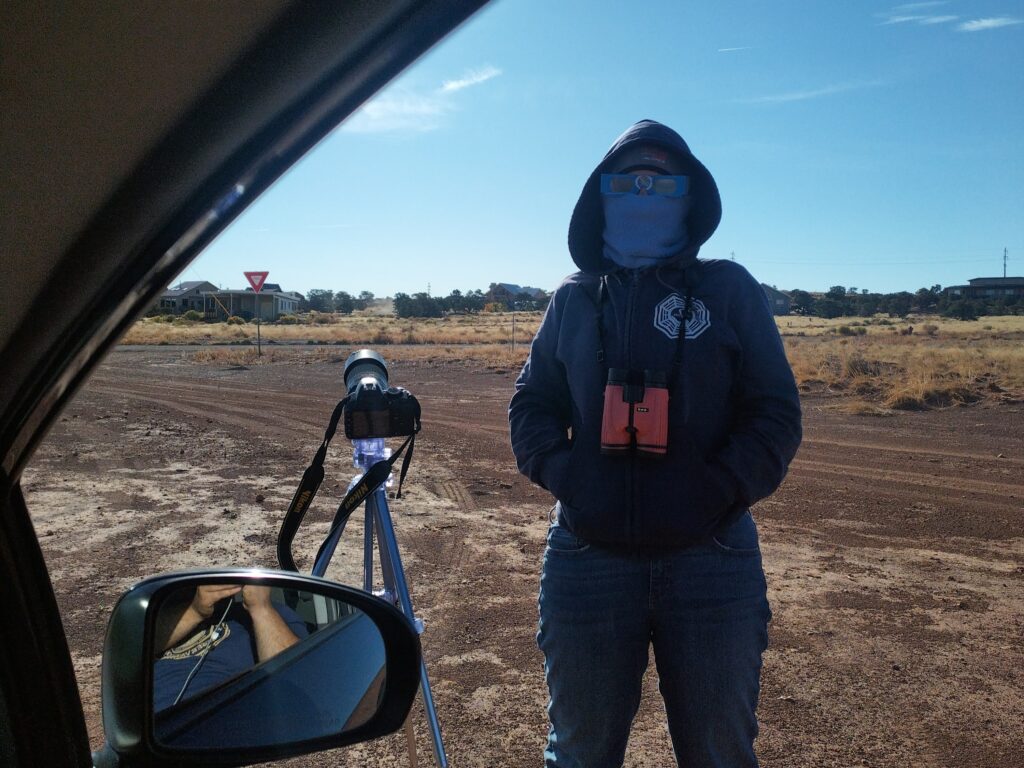
The reason for these variations in what we see is based on the moon’s distance from the earth. If the moon is farther away in its orbit, it appears visually smaller to us, and therefore covers less of the sun. Annular eclipses happen with regularity around the world, about every 1-2 years, [1] which is similar to total eclipses. [2] An interesting (but not-so-fun) fact is that eventually there will only be annular eclipses, as the moon moves farther away from earth in its orbit. (The timeline for that is on the order of billions of years, [3] so no time soon.)
Although I had technically seen an annular eclipse in the ‘90s, it was only partial (i.e. not full annularity in my hometown), but I still remember the buzz in my fourth grade class when they brought us inside from recess so we wouldn’t damage our eyes. We ran back to the building screaming with the urgency that indicated a life-or-death situation. Maybe it was a result of having our routines impacted by this celestial event, but something felt fundamentally different in the air that day – the feeling that something was not right. I also remember that we didn’t particularly do much work; I for one sat on the floor, talking to my friends while teachers took us out in small groups to look at the eclipse through photo negatives.
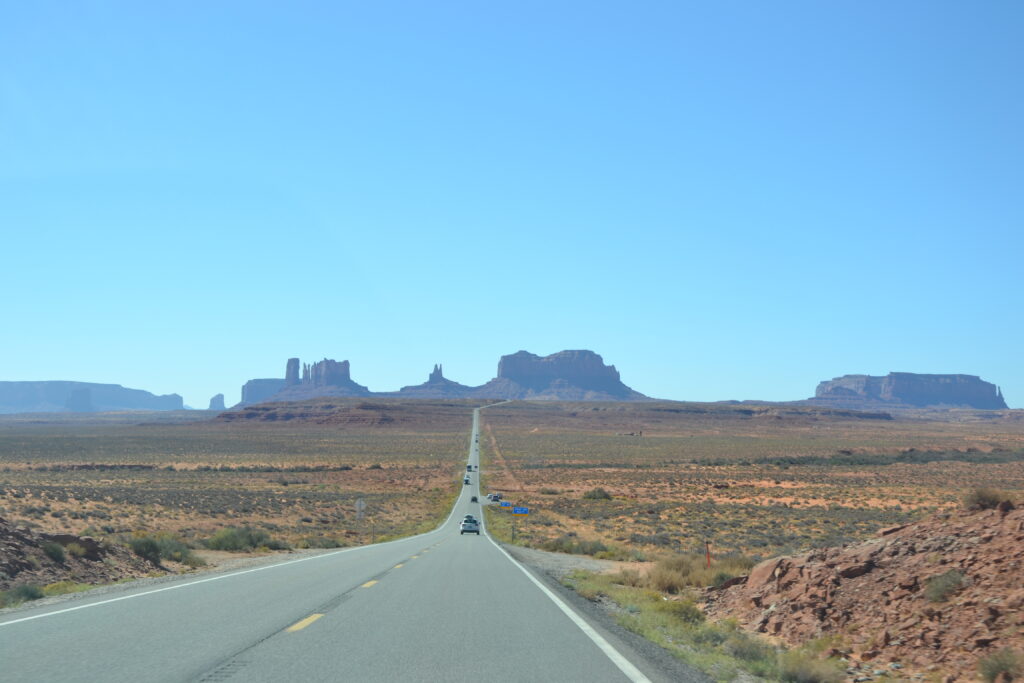
It was an odd feeling to see a chunk missing from the sun, and getting to see that myself at an impressionable age probably added significantly to my interest in astronomy. By the time I was in college, I worked at the school’s observatory, tutoring astronomy students and running our research grade telescope a few nights a week. I got to experience some very cool sights there, including a lunar eclipse and the transit of Venus across the sun (visually small events like that are called transits, not eclipses), but I didn’t see another eclipse until much later.
You Never Forget Your First
The year was 2008, and Beijing was hosting the Olympics. Opening ceremonies were on 08/08/08 (which would have been my grandma’s 100th birthday), just days after a total solar eclipse, which was visible in western China. In an organizational feat of travel planning that impresses me to this day, I crossed three items off my bucket list in the span of a few weeks (the third was petting a panda), all while jumping through hoops for a Chinese travel visa that made my college application look like signing up for a library card.
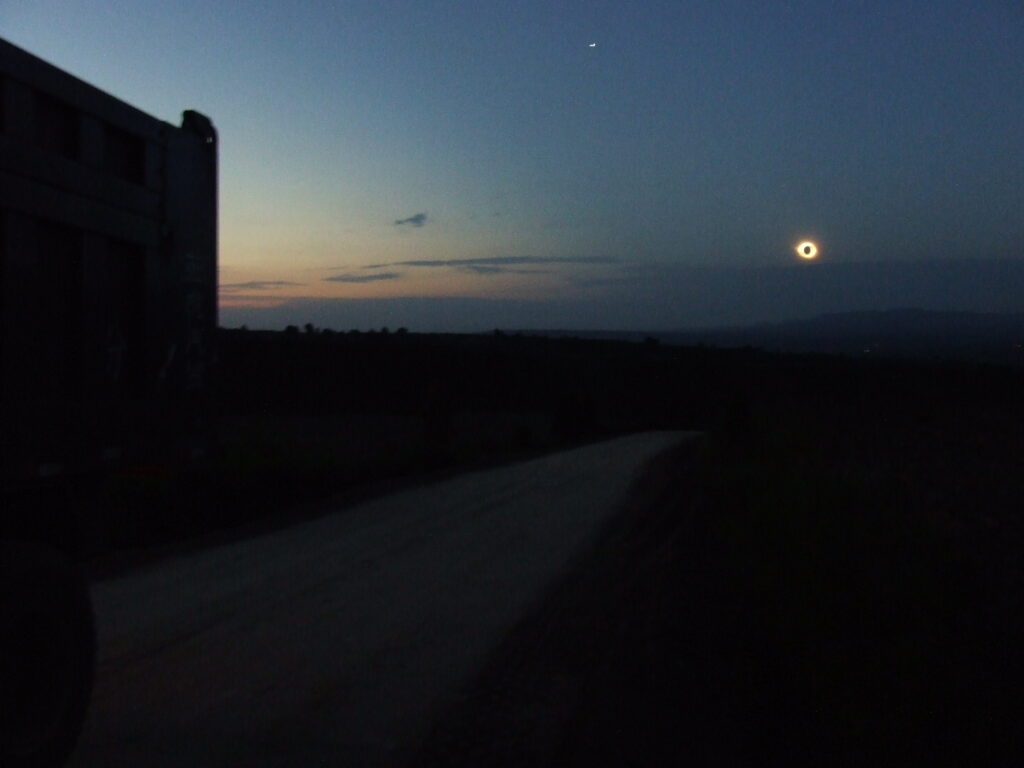
Photo credit: Arthur Parisi
I was joined by my best friend from college on this adventure, and once we made it to the nearest town, I hired a driver to get us to the path of totality. Not willing to drop cash on a solar filter lens for my camera (which would have been about 10% the cost of the trip to China), I dissected a pair of eclipse glasses and taped the filter to my camera lens. Once we arrived in the middle of nowhere, we got out of the car, set up the camera, and waited. There’s probably nothing that compares to the experience of one’s first total solar eclipse, but my second (in Tennessee, to which I dragged Christian a week before our wedding reception in 2017) had much the same effect, even though I was slightly more prepared.
The way I have described the experience is that when witnessing the source of all life on the planet disappear from the sky and leave a gaping hole where it should be, every cell in your body screams that something is very, very wrong. Staring at that hole in the sky with the naked eye also adds a sense of vulnerability to what is already a sense of dull but primal terror. I didn’t think it was possible to over-sell the experience, but when I asked Christian what he thought in Tennessee, he shrugged and said “it was cool.”
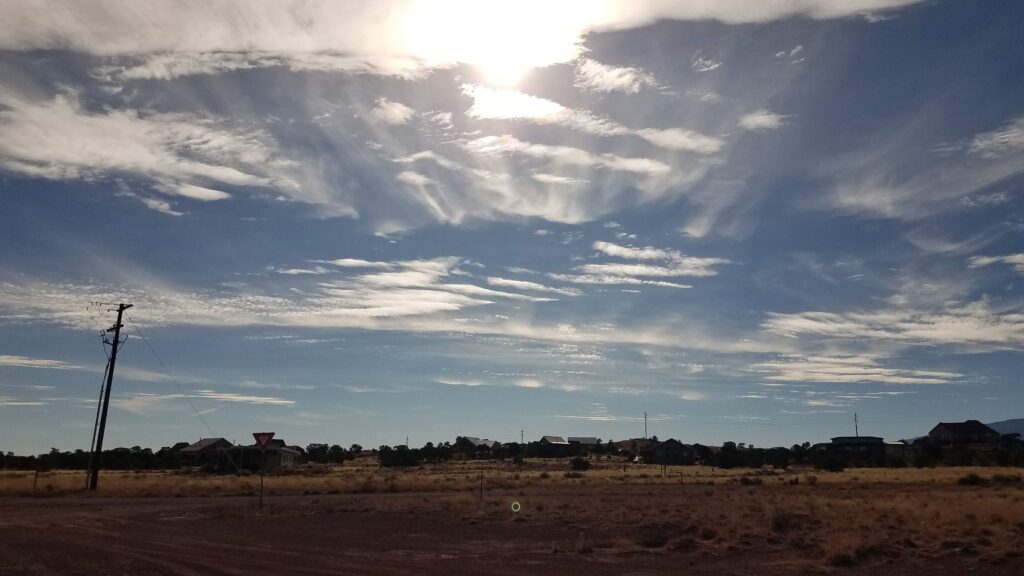
This one, the annular eclipse, would be different, though. Since the moon appears smaller, the proportions seem to be off, making an already unnerving experience even weirder. Some of the best photos I’ve seen of annular eclipses are in the crescent phase, not full annularity, which lends an aura of sci-fi to them. And since the sunlight is not completely blocked even at the peak, you cannot view it with the naked eye. That would mean some additional equipment. This time, I was willing to drop some money for a pair of solar binoculars, which, aside from eclipses, can be used for viewing transits and sunspots.
Planes, Trains, and Automobiles
Getting there was the question, though. As I mentioned in previous posts in this series, we hadn’t started planning for this trip very far in advance, but we had 1,850 miles of options from which to choose. And ultimately, flexibility is key when planning: ideally, you will have access to a car and a good weather app in the days leading up to the event, making sure you keep checking the radar on the day of. For instance, we had great conditions for the 2017 eclipse in eastern Tennessee, but friends in western North Carolina had nothing but clouds.
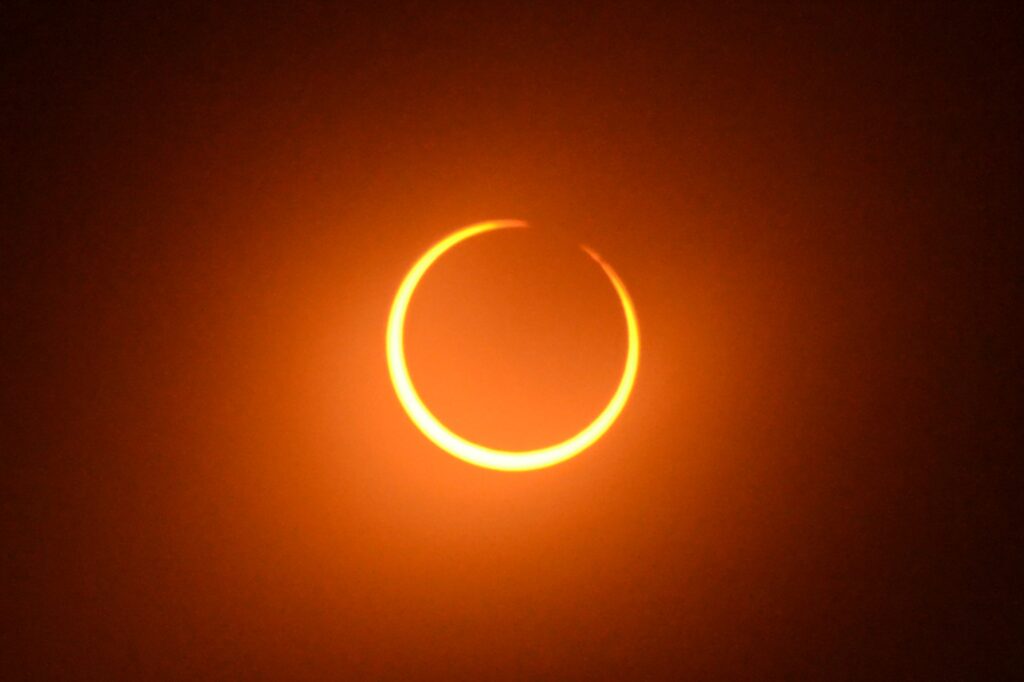
As much as I would have liked to visit my dear friend who lives in Oregon, we (correctly) assumed that visibility would be poor there. New Mexico was my leading choice, and it probably would have remained so if this trip had only been a long weekend. Once it became clear that we were going all-in for a two-week road trip, our general route would likely put us somewhere in Utah on October 14. We wanted to avoid touristy places like Four Corners or Monument Valley, but fortunately that part of the country gives you a lot of room to spread out.
Part of the problem with staying flexible regarding viewing location is the difficulty it adds to securing lodging. In 2017, we camped outside Pigeon Forge; this time we stayed with friends in Grand Junction, CO and got on the road at 3am, driving through hours of insanity-inducing blackness toward Torrey, UT (about half an hour from Pando [5]). When we were planning the trip, Christian had initially suggested renting an RV. I said no at the time but ultimately felt guilty about my strong opinion, since having a mobile hotel room would have helped us quite a bit on the nights before the eclipse and Trinity. [6]
Worth a Thousand Words
But we made it, tired, cold, and grumpy. We had enough time to grab some breakfast burritos and Mexican coffee and find a place to set up shop. Since I wanted to try my hand at creating a composite photo of eclipse images from start to finish, I insisted we be ready to go with time to spare before it started. My tripod (the same one that went to China) turned out to be more broken than I expected, so stabilization with electrical tape was in order… as was my tried-and-true discount camera filter, which I had to assemble in the car because it was so cold that I lost the necessary dexterity in my fingers. I set timers on my phone so I could jump out of the car and take photos at regular intervals for my composite shot. Christian got out a few times but mostly watched from inside the car.

As uncomfortable as it was standing in the cold, I was still taken aback by the sheer creepiness of watching the moon slide in front of the sun – now with the binoculars and a “new” camera I had bought from a friend several years prior and was finally trying out. Unfortunately, as I would discover later, the photos I took were not going to work for a composite shot because my auto setting used different apertures and shutter speeds for each photo. The result is many images of different color and brightness, some fuzzy because of the light cirrus cover (despite nothing on the radar), and some blurry because of my wobbly tripod.
But while the photography didn’t work out as I had expected, the experience of being there for it was the important part. There were still some similarities with a total eclipse: the light gets weird – almost like a desaturation of color and an increase of contrast, the temperature drops a little bit, and animals start behaving strangely. But because you can’t stare agape with your own naked eyes at something that just shouldn’t be (which can’t happen during an annular eclipse since you have to view it through eclipse glasses, solar binoculars, or a camera the whole time) there is a feeling of being one step removed from it. Nevertheless, I am still thrilled that I got to see this especially weird event, but Christian said that’s the last one I’m dragging him to.
Epilogue
One week after we saw the eclipse and Pando in Utah, we saw Trinity and the Very Large Array in New Mexico. As exhausted as we were after spending the night in line outside White Sands Missile Range, there was no question that we would spend some extra time in the car to see the VLA once we discovered that it was “only” two hours away. I have a special place in my heart for any telescope, but I’m always excited when I’m able to visit important ones, such as Arecibo Observatory (once in high school and again with Christian the month before we got married), [7] and now this set of 27 radio telescopes in the middle of the desert. [8]
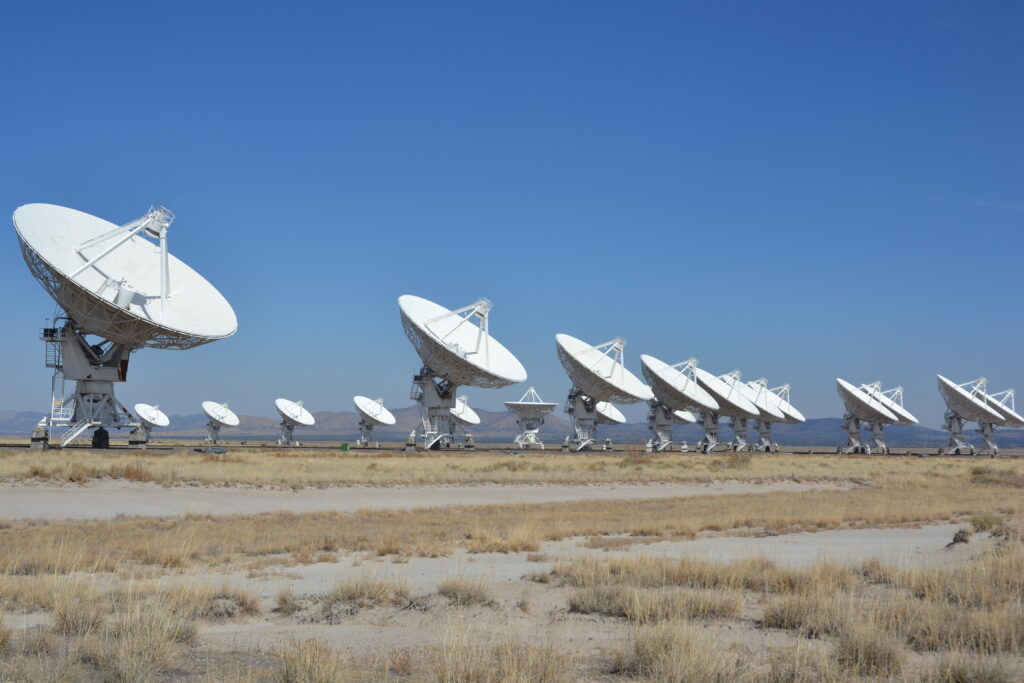
As important as these radio telescopes are (or were, in Arecibo’s case) for science, they were also iconic in science fiction, most notably in the movie Contact. [9] Contact was a much-beloved movie of mine when it came out in 1997, and Carl Sagan’s book, [10] which inspired the movie, was assigned in my freshman seminar on sci-fi literature. Coincidentally, that same seminar professor taught astronomy and was the first (but not the last) person in the physics department responsible for the fact that I ultimately did not major in English as originally planned.
Wiped out from our jam-packed, two-week, 3,000-mile road trip across four states, and after packing for our early flight home early the next morning, Christian and I crawled into bed with two cups of our very nice bourbon (which we had rescued on our way back out of White Sands) and started that movie, which was so inspirational for me in the ‘90s when my interests and intellect and perspectives were really starting to grow. Maybe there’s some confirmation bias in identifying all the connections with ‘90s nostalgia on this trip, or maybe there just are some really meaningful and amusing throughlines between my life now and when I was coming of age. Either way, this trip was a joy for me as I visited and revisited things that have shaped me as a person.
Wrapping up for now with many more thoughts to share in the future.
Thanks for reading!
[1] https://www.exploratorium.edu/eclipse/three-kinds-solar-eclipses
[2] https://www.nhm.ac.uk/discover/solar-eclipse-guide.html
[5] https://radicalmoderate.online/not-all-those-who-wander-are-lost-but-some-are/
[6] https://radicalmoderate.online/batter-my-heart-three-persond-god/
[8] https://public.nrao.edu/visit/very-large-array/
[9] https://www.imdb.com/title/tt0118884/
[10] https://www.goodreads.com/book/show/53000876-contact
0 Comments